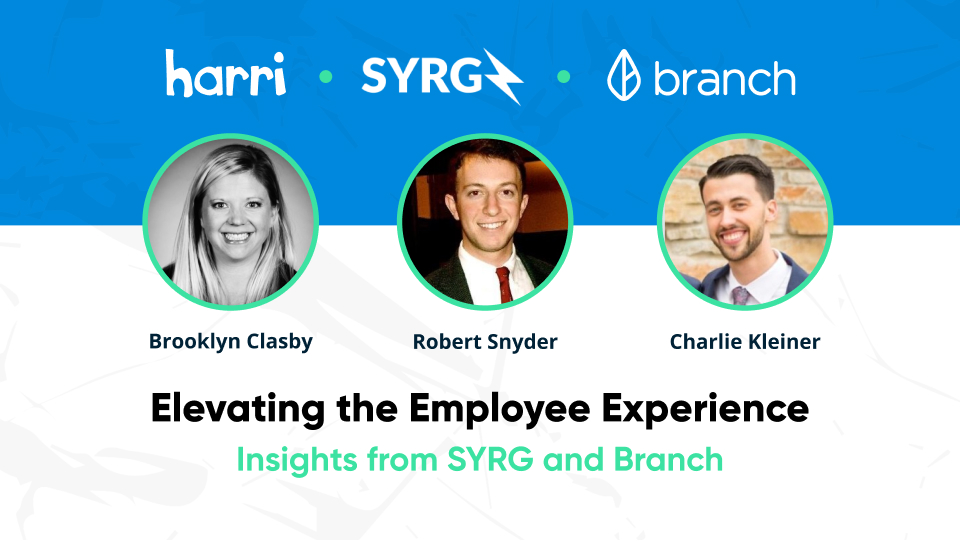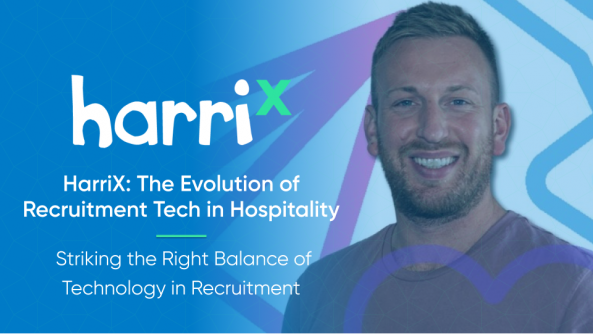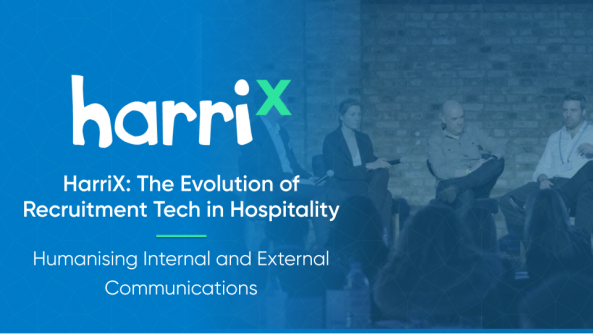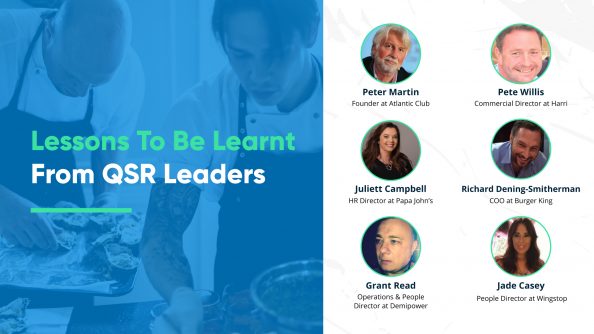Webinar Recap: Elevating the Employee Experience with SYRG and Branch

- By Harri Insider Team | May 6, 2021
How can hospitality brands build for the future? By focusing on the employee experience to attract and retain talent. Brooklyn Clasby, Senior Enterprise Account Executive, at Harri, met with Robert Snyder, Co-Founder of SYRG, and Charlie Kleiner, Manager of Field and Partner Marketing, at Branch, to discuss how hospitality operators can take a tech-driven approach to improve the employee experience.
How the employee experience impacts hospitality’s reawakening
In an industry that’s notorious for being “all turnover all the time,” the panelists start by discussing the employee experience as it relates to the guest experience.
Brooklyn noted that, although the guest experience will never surpass the employee experience, a majority of tech platforms out there only focus on the guest. But why should employers start shifting focus towards employee-first solutions?
According to Charlie, it’s because the guest experience and the employee experience are connected, “your brand is your workforce. Your employees are interacting with your customers every day. If they’re not satisfied, happy coming into work, or don’t feel like their employer cares about them, that will reflect in how they interact with guests.
Rob points out that, although the hospitality industry always knew we’d get to a point where the employee experience was so vital, we didn’t know it would come in a span of 12 months. As workers move onto pandemic-safe industries or jobs with better flexibility like Uber, “the employee experience is a way to compete in this market.”
Brooklyn doubles down on this with an example of how regional restaurants can’t open dining rooms because they don’t have the labor to support such operations. Many can only handle carryout and takeout. Until these brands create consistently enticing employee experiences, they’ll continue to fumble with labor supply.
How misguided technology creates a flawed experience
If COVID-19 brought any silver linings, it’s that it accelerated operators’ attention to tech-driven employee experience initiatives. Charlie explains how technology has evolved over time:
“We saw kiosks that let guests order without having to interface with an employee. We’ve seen more ways for guests to pay for their purchase, like tap-to-pay or ApplePay. Everyone was focused on digitizing the guest experience as much as possible, but now the employee experience doesn’t match that.
On the employee side, we’re still using outdated methods for everything from hiring to paying people. That has to catch up to the guest experience.”
Brooklyn followed up on flawed employee experience tech, “we have these technologies designed in silos. This solves for employee benefits and this solves for scheduling…I think that fragmentation is playing into turnover because we can’t get candidates in and we can’t retain them.”
Rob points out that these technologies were designed for hiring processes where there were more candidates than available jobs and as a result, cause major friction during a labor shortage. Fragmented systems mean that employees often have to go through many hoops just to apply to a position, and that process pushes them away.
Trends in employee experience challenges facing businesses post-pandemic
The panelists discussed how employees who left hospitality due to the pandemic aren’t in a rush to return — partially because they felt unsafe, but also because they don’t feel like their employers care if they left.
Rob noted that, as SYRG onboards new hospitality professionals, they ask what are the greatest employee experience challenges they’re facing. They noticed three trends, “getting the employee experience right, knowing what you want your employee experience to be, and how you want to compete with other employee experiences.”
He uses scheduling as an example. Flexible scheduling might be impossible in hospitality, especially compared to Uber. How will you supplement that to make people want to come to your organization?
Employers need to go the extra mile to get candidates and workers excited about hospitality and consider career path opportunities within the industry.
Charlie agreed, stating that you need to be competitive in terms of benefits, “people need their money ASAP, we can’t keep restricting them to a 2-week cycle for money they’ve earned. Think, how else can we incentivize employees to pick up more shifts?”
Keeping up with ever-evolving tech is a must in the race for talent
When asked about barriers or areas of friction that affect employee financial wellness, the panelists bring attention to clunky processes that don’t utilize technology.
Charlie used compensation as an example, specifically the concept of same-day pay, “operators fear employees will get irresponsible if they get paid every day. But there are so many tech solutions that allow the payment process has to be a lot easier. Now we’re seeing more of a concept of same-day pay.”
And according to data from Branch, that same-day pay tends to only be taken in emergencies, “employees are using same-day pay when they need gas, the car broke down, or they have an unexpected hospital bill. It allows them to overcome an emergency, get to work, and be financially better.”
Brooklyn notes how at one time in the industry, candidates had to follow up with employers in hopes of getting even an entry-level job. Nowadays, the tables have turned. According to Rob, applicant quality hasn’t decreased.
There simply are fewer candidates that want to work in the industry and make it through the application process in full. “Keep in touch with people and share why your workplace is such a great place for them to work. Technology helps us get those messages out at scale and helps managers have human conversations that bring great candidates in.” Even doing something as simple as adding a phone number for applicants to get in touch with a manager can go a long way.
Measuring and quantifying the employee experience for hourly workers
You can’t fully understand what makes a great employee experience unless you start measuring it. The panelists discussed different ways managers can find stories in employee data.
And for employee-facing metrics? Stability is key to ensure retention. “A big piece of stability is your life outside of work. What else can you do to offer your employees to be financially stable outside of work without picking up a second or third job just to afford groceries?”
While employee surveys are common to gauge this data, Rob makes an important note in the quality of this measurement tool, “annual surveys make no sense if your annual tenure is three months.”
An idea he shared is hiring surveys, “understand the biggest problems and uncertainties they faced during the hiring process. Even people that didn’t get hired — what happened?”
Charlie encourages operators to dig deeper than employee surveys, “metrics like turnover and retention are great, but one thing I really like, especially in the restaurant space, is referrals. How many people are hired because they know somebody at your company?”
After all, if people are coming to work for you through a referral, it means your employees love their jobs and trust you. And at the end of the day, you don’t want employees leaving for predictable reasons.
Brooklyn followed up with an excellent point regarding employee experience metrics and costs, “a lot of people at the top levels want to want to quantify [the ROI of a new hire] to justify spend on technologies, but you can’t.”
Rob agreed and emphasized the importance of soft ROI, “the ROI of a new hire today is worth so much more to people. In a world where there are more jobs than people, it’s the difference between having a workforce and not. Being able to open and not. If you’re trying to calculate the ROI on the employee experience, it’s infinite.”
The applicant experience: a vital precursor to the employee experience
SYRG conducted a study of job seekers asking: If you apply to 10 jobs, how many will you hear back from? A vast majority said one or two.
Why the low numbers? According to the data, a vast majority apply to everything they possibly can, only to be contacted by employers with an informal message mispronouncing their name. It starts the entire process, therefore the employee experience, off on the wrong foot. That creates friction and drop-off.
That’s not to say the company is a terrible place to work, but it shows that managers are going through so much that they physically don’t have the time to dedicate to creating a great hiring process.
Personalization goes a long way here. Even if you don’t get back to candidates in a timely manner, sending an honest end personalized note resonates extremely well.
Rob states that “you need to set a positive expectation from the first interaction. You don’t want to recover labor on day one or week one.”
He also recommends taking a recruitment marketing approach — letting candidates know that you care about their hiring experience from the first touchpoint all the way through the full cycle of the employee experience.
Brooklyn makes a great point saying that even if a candidate isn’t a good fit now, that doesn’t mean they won’t be a good candidate in six months. Managers should be able to deliver that message rather than ghosting them. Maybe the candidate just needs more experience.”
To watch the full webinar, click here




















